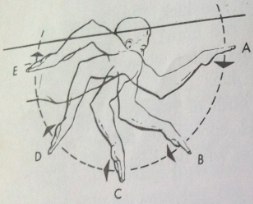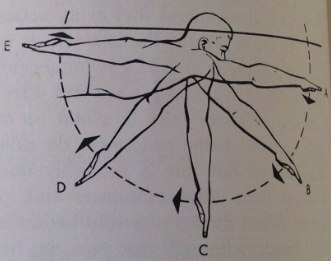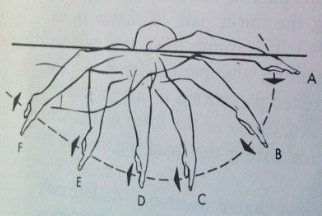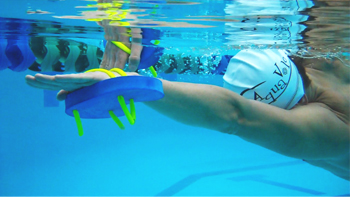VoloBlades: Shifting The Center Of Pressure Down To The Lower Palm.by eduard on Sat, 06/29/2013 - 13:19.
Swimming paddles were invented in the beginning of the 18th century. In the following 300 years, they have gone through manifold of successive alterations but the overall concept has remained the same. With the exception of finger- and anti-paddles, the traditional swimming paddle has a surface area slightly bigger than the swimmer’s hand and covers the hand and the fingers entirely. With such a surface area, the paddle’s center of pressure is located approximately between the swimmer’s upper palm and fingers as indicated by the intersections of the two red lines in the image below:

We thought that by shifting the center of pressure down to the lower palm we could design a more effective swimming paddle. To achieve this, we made the swimming paddle shorter and wider. The top edge of this new swimming paddle, which we named VoloBlades, does not extend beyond the top of the palm, allowing for the fingers to retain absolute freedom of movement. Because VoloBlades are shorter and wider, their center of pressure is located in the lower palm, as indicated by the intersection of the two red lines on the image below:

The benefits of a swimming paddle with a lowered center of pressure will become evident when we evaluate two activities during which the arms move in a similar manner to the movements during the pull phase of a swim stroke.

Suppose you are pulling yourself up onto the deck from the deep end of the pool. You place your hands on the deck and push down with the lower parts of your palms. You automatically do this, because subconsciously you know that it is the position from which you will generate the most power. By pushing down with the lower palms, you are recruiting bigger muscles, the lats specifically, which enable you to generate enough power to pull yourself onto the deck.
In contrast, if you try to pull yourself up onto the deck by pushing down with the upper palms or fingers, you will notice that it is significantly harder. By pushing down with your upper palms or fingers, you are recruiting smaller muscles, the triceps and shoulders, which are not as powerful as lats, making the task of pulling yourself up onto the deck nearly impossible.

If, however, you try to push down on the handle with the top parts of the palms or your fingers, it becomes virtually impossible to extend forward even a little bit without falling down. You fall because by pushing down on the handle with the upper palms or the fingers, you are recruiting smaller muscles, triceps and shoulders, which cannot generate as much power as the lats and the core and which cannot sustain your weight in the air.
Both examples describe arm movements analogous to the arm movement during the pull phase of the swim. Pulling yourself up by pushing down on the deck is equivalent to pulling yourself forward by pushing down on the water. Likewise, rolling out and then back in on the abs wheel is similar to pushing down the water during the pull phase of the stroke.
Furthermore, both examples demonstrate that pushing with the lower part of the palms generates significantly more power than pushing with the upper palms or the fingers. The same is true for swimming: pushing down the water with the lower palm during the pull phase of the swim generates more power. All other things equal, a swimmer with a more powerful pull will swim faster.
VoloBlades, due to their unique design, shift down the center of pressure, encouraging swimmers to pull with the lower palm. In addition, VoloBlades help swimmers develop awareness of what it feels like to pull with the lower palm as well as awareness of the connection between the hand, the arm and the core.


Swimming paddles have been around for almost 300 years. In that time, there have been numerous minor alterations but neither the overall concept nor design has changed significantly. VoloBlades, however, stand out because of their unique design and because of the way that they mimic natural movement, capitalizing on core muscles to help swimmers get stronger. We believe that VoloBlades will help you become a faster and more efficient swimmer because VoloBlades help develop a more powerful pull and bring about overall awareness of the connection between the hand, the arm and the core, all of which are necessary components for efficient and fast swimming.
What is AquaVolo Band?
AquaVolo Band is a resistance training tool. It is used to develop an efficient flutter kick and raw power.
Though DragSox and AquaVolo Band are both designed for power training, they work and strengthen the legs in different ways.
While DragSox are designed for kicking, technique and drills, AquaVolo Band is meant strictly for building strength and power in a short compact kick by engaging the core, hips and upper leg muscles. It also encourages a much faster kick tempo.

Other uses for AquaVolo Band
Basic Balance Drills with AquaVolo Band:
Used around the upper body, binding arms at the waist, it isolates arms and encourages swimmers to use hips and core for balance and rotation rather than compensating with arms.

Breaststroke Kick
AquaVolo Band can also be used around the knees to help teach proper breaststroke kick.
Introducing VB AIR by eduard on Thu, 04/03/2014 - 18:06.
There are three common types of underwater arm pull in swimming:
1) the dropped elbow arm pull;
2) the straight arm pull; and
3) the high elbow arm pull.
Here is how James Counsilman describes each in his book, The Science of Swimming (1):
"The dropped elbow arm pull is the poorest type of pull and provides the swimmer with very little forward propulsion, since very little water is pushed backwards.

Dropped Elbow Pull
"The straight arm pull is better than the dropped elbow arm pull so far as effectiveness is concerned, but at points A and B the force applied downward is too great, and at points D and E the force applied upward is too great. This tends to push the swimmer upward at points A and B and downward when the hand is at D and E.

Straight Arm Pull
"The best pull is that which will minimize the dropped upward and downward components of the straight arm pull and provides a greater push backwards. It begins almost as a straight arm pull except that the elbow is higher. The elbow bends during the pull and then nearly straightens as the pull finishes.”

High Elbow Pull
The “best pull" here is synonymous with fast and efficient swimming. One of the prerequisites for the “best pull” as seen in the illustration above, is the high elbow catch (the arm position between the points A and B). To achieve the “best pull” the swimmer must first establish a high elbow catch, which is why the high elbow catch is considered a critical component of fast and efficient swimming. Swimmers and coaches dedicate a lot of time and effort to refining the technique involved in high elbow catch.
When we learn a new movement, our brain generates new motor pathways that carry the signals from the brain to the body parts responsible for that movement. For instance, if the swimmer consistently drops her elbow during the catch, the brain sends the information necessary to perform that particular movement (dropped elbow catch) to the appropriate body parts along established motor pathways. Let’s call these pathways the "dropped elbow catch" motor pathways.
If this swimmer wanted to develop a high elbow catch (a new movement), she would first have to develop the new “high elbow catch” motor pathways that would carry the appropriate signals from the brain to the body parts responsible for the high elbow catch. For the brain to activate new motor pathways, however, it needs to receive certain information related to the new movement. A logical question to ask at this point is: How can the swimmer perform the new movement in order to send the information related to this movement to the brain, if she doesn’t know how to perform the movement? It feels like a chicken and egg question, but the answer is to do drills and use tools that emphasize certain parts of a stroke and stimulate active thinking at critical moments. Drills allow the swimmer to perform in a consistent manner, over and over in order to refine a specific movement. Appropriate tools bring the swimmer’s attention to specific aspects of a stroke and/or build awareness of the water and the muscles involved in particular movements. VB AIR is one of such tools.

VB AIR
VB AIR inherit their design from our popular VoloBlades paddles. As we have written before, the design of VoloBlades shifts the point of pressure down to the lower palm, which promotes a high elbow catch and quick engagement of core muscles, resulting in a faster and more efficient swim. Furthermore, due to the unique design of VoloBlades, the fingers have direct and unobstructed contact with water, which is a crucial requirement for increasing the feel for water. VB AIR have an additional unique property: they are buoyant. To overcome this buoyancy, the swimmer has to exert extra effort when her arm enters the water and establishes the catch. When the swimmer is forced to exert extra effort in an unexpected place, it brings about awareness of that particular place and time. It forces the swimmer to pay closer attention to the details of the movement that she is performing.
Pushing down with the lower palm on the buoyant VB AIR promotes superior high elbow catch. The design and the buoyancy of VB AIR in combination with the swimmer’s awareness and active thinking during the catch phase create an environment in which the swimmer is able to make adjustments necessary for improved high elbow catch. As it happens, the information related to the high elbow catch is sent do the brain that begins to activate new “high elbow catch” motor pathways. "The more particular pathway is activated during consistent, purposeful action, the likelier it is to be stabilized."(2) VB AIR allow for this consistent, purposeful action and the creation of an automatic high elbow catch.
References
1. The Science of Swimming. James E. Counsilman (1968)
2. What's Going On In There. Lise Eliot (2000)
Do Finger Paddles Increase "Feel For Water"?
by eduard on Tue, 02/18/2014 - 07:34.

Finger paddles, sometimes also known as sculling paddles, are frequently touted as paddles that help swimmers increase their "feel for water." Evidence to support this claim, however, is never provided.
One way to think about the feel for water in this particular context is as a sense of the position and the movement of the swimmer's hand in the water. This sense is vital when swimmers want to improve technique. For instance, if a swimmer tries to improve her hand entry and catch, she needs to be aware of the precise position and movement of her hand first. Once she has that awareness, she can work on improving it. In other words, she cannot improve something that she is not aware of. Mindful swimmers work hard to increase their feel for water so they can then refine their technique.
Where does this sense of the position and movement, or the feel for water come from? What events trigger this awareness? What information does the brain receive that allows it to create an accurate map of the swimmer's hand position?
This information starts with the fingertips. Fingertips are one of the most sensitive regions of human body. In fact, "there is a hundred-to-one ratio of touch receptors in your fingers compared to your torso."(1) The more sensory receptors, the more information reaches the brain. It is this information, originating from the fingertips and processed by the brain, that allows the swimmer to know her precise hand position and the movement in the water.
They key point to understand here is that when the swimmer presses the water, the fingertip receptors are activated. "These special receptors translate mechanical pressure into long-distance electrical signals" (2) and send them to the brain. The brain then processes this information and provides the swimmer with a sense of the hand position and movement, or the feel for water. It is important to emphasize that the source information provided by the fingertip touch receptors determine the feel for water.
Now that we have this insight, it is easy to see that the feel for water with the finger paddle will be quite different from the feel for water with bare fingers. When you press water with bare fingers, the water flows around, over and between the fingers. The finger receptors, having direct and unobstructed contact with water, collect accurate and relevant information and send it to the brain, resulting in the accurate feel for water. Inserting a finger paddle between the fingers and the water dramatically changes the information collected by the fingertip touch receptors: the sensory input from water, a liquid, is fundamentally different from the input from a solid paddle.
By shifting the fingertip touch receptors from water and placing them onto a solid surface, finger paddles deprive the fingertip touch receptors from registering as much crucial information necessary to increase the feel for water. In essence, you create a barrier between the sensory collector and the environment. It's analogous to putting on opaque glasses to see more. Your eyes may register the inside of the glasses, but they won't register what is beyond them.
In conclusion, to increase the feel for water, it is crucial to have unobstructed contact between the fingers and the water. Only when the fingers have unobstructed contact with water, the fingertip receptors can provide the brain with accurate and relevant information that will result in a more accurate feel for water. Inserting a finger paddle between the fingers and the water will only increase the feel for solid surface. In this case, swimming with finger paddles is more likely to increase the feel for plastic than the feel for water.
Reference
1. The Body Has a Mind of Its Own. Sandra Blakeslee and Matthew Blakeslee (2007)
2. What's Going On In There. Lise Eliot (2000)
DragSox and Blades by Gavin on Fri, 04/25/2014 - 10:49.
Warm Up
4x 25 Over Kick as distance/stroke
Pulling with VBs
3x (3x 50 pull @ 1:00, :50, :40
extra :30 to change gear)
Round 1 with VB AIR
Round 2 with VoloBlades45 and ZB Weights 1/2
Round 3 with VoloBlade60
DS Progression
3x 50 kick @ 1:30 with DragSox45
4x 25 sprint swim @ 1:00 with DragSox45
2x 25 sprint swim @ 1:00 no gear
50 easy
4x 25 @ 1:00
1 and 2 kick with 2 pairs of DragSox45
3 kick with 1 pair of DragSox45
4 sprint swim, no gear
50 easy
25 sprint kick with DragSox45
25 sprint swim, no gear
Cool Down
Breaststroke with DragSox
Michael Osborne | Warrior Aquatic Club
DragSox and BR fins with Thorlo athletic socks under the BR fins:
- 25 BR kick (recovery) on the back (kicking right leg, left leg, both legs) is usually on :50 to 1:00
We will do
- 25 BR kick + 25 BR kick on back (see above), 25 on front is on :25
- 50 BR kick + 25 BR kick on back, 50 is on :55 or 1:00
- 75 BR kick + 25 BR kick on back, 75 is on 1:25
- 100 BR kick + 25 BR kick on back, 100 is on 1:50
and we will repeat this once or twice
Here is a whole “pre-set” using fins and DragSox:
- 8 x 25 BR with dolphin kick, on :30
- 4 x 25 dolphin kick on :30
- 8 x (:20 vertical dolphin kick + :20 rest) alternate thumbs up (above the surface)/thumbs down (only the thumbs are in the water – rest of the arms are out)
- 4 x 25 BR with dolphin kick on :30
- 6 x dolphin kick rockets (shoot off the bottom of the pool – 12 feet deep – in a streamline) – have to watch for sensitive ears on this one due to water pressure
- 6 x 25 BR with 2-BR kicks/1-pull, on :30
Underwater BR kick relays across the pool (20 yards) – try no breathing (for age group)